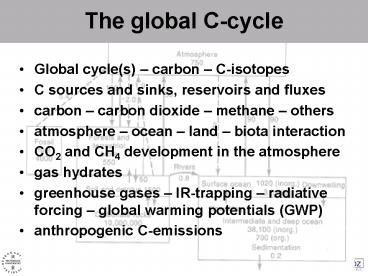The global Ccycle - PowerPoint PPT Presentation
1 / 19
Title:
The global Ccycle
Description:
atmosphere ocean land biota interaction. CO2 and CH4 development in the atmosphere ... C-isotope spreads in biota and oxidized C compounds (black) from ... – PowerPoint PPT presentation
Number of Views:26
Avg rating:3.0/5.0
Title: The global Ccycle
1
The global C-cycle
- Global cycle(s) carbon C-isotopes
- C sources and sinks, reservoirs and fluxes
- carbon carbon dioxide methane others
- atmosphere ocean land biota interaction
- CO2 and CH4 development in the atmosphere
- gas hydrates
- greenhouse gases IR-trapping radiative
forcing global warming potentials (GWP) - anthropogenic C-emissions
2
Atmospheric CO2 development
CO2 (ppmv)
Global annual CO2 emissions from fossil fuel
combustion and cement production in Gt C per year
(log scale). After Watson et al. 1990 in Berner
Berner (1996)
ka before present
- after data from Vostok ice core. T-determination
after Gassmann (1992) in Hupfer (1996)
3
Global cycle(s) interactions
- Interaction of the endogenic with the exogenic
cycle. Boxes represent reservoirs, arrows the
processes. The two mega-cycles are mainly
connected through sediment and soil. Mind
reversible and irreversible processes! - Ultimate source for all matter is the Earth
mantle plus some extraterrestrial matter. - from Faure (1992) fig. 23.2
4
Global geochemical C-cycle
- Ci inorganic carbon (carbonate and CO2)
- Co organic carbon (hydrocarbons, carbohydrates,
etc.) - C native C (graphite and diamonds)
- from Faure (1992) fig. 23.3
5
The global C-cycle
- Reservoirs in Gt C. Fluxes in Gt C per year.
Dashed lines anthropogenic influence solid
lines natural fluxes. after several sources in
Berner Berner (1996)
6
C-isotope ratios
from Schidlowski (1995)
- C-isotope spreads in biota and oxidized C
compounds (black)
7
Box model of the global C-isotope cycle
- d13C averages in brackets. KIE kinetic isotope
effect, responsible for the preferential
accumulation of 12C in organic matter with 13C
retained in marine carbonate. - from Schidlowski (1995)
8
CO2 in the troposphere
- Mean monthly atmospheric CO2 at Mauna Loa, Hawaii
19581993 (Keeling, 1994). Oscillation annual
cycle of photosynthesis and plant respiration. 1
ppm CO2 2.12 Gt C 109 tons C 1015 g C
9
Atmospheric CO2 development
CO2 (ppmv)
Global annual CO2 emissions from fossil fuel
combustion and cement production in Gt C per year
(log scale). After Watson et al. 1990 in Berner
Berner (1996)
ka before present
- after data from Vostok ice core. T-determination
after Gassmann (1992) in Hupfer (1996)
10
CO2 fate
- Only about 42 of the CO2 emitted since 1800 AD
has dissolved in the oceans. Of 100 molecules of
CO2, injected into the atmosphere, - the following scenario seems valid for
dissolution in the ocean - 6 dissolve within 1 year
- 29 dissolve within 10 years
- 59 dissolve within 60 years
- 84 dissolve within 360 years
- 100 dissolve within gt1000 years
Scenario for further increase 19902200 from
Seinfeld Pandis (1998) fig. 21.15
11
Global average CH4 (ppmv)
CH4 was ca. 0.9 ppmv prior to 1890s. Increase
due to human population growth and agricultural
practises.
Global CH4 at the marine boundary layer. Higher
values in the N-hemisphere, seasonal variation
and long-term increase
- from NOAA (2000)
12
Sources and sinks for atmospheric CH4
- after several IPCC sources in Berner Berner
(1996)
13
Gas hydrates CH4
- oil, coal, gas
- 5,000
gas hydrates 10,000
soils 1,400
atmos. mar. biosph. 6,6
DOM 980
terr. Biosph. 830
peat 500
POM 60
Worldwide locations of known and inferred CH4 gas
hydrates in aquatic sediments () and permafrost
regions () from Henriet Mienert (1998)
14
Gas hydrate mobilisation
W
E
- water depth (m)
CH4 vanes over gas hydrate fields. Concentrations
in nL L-1
Burning ice. CH4 self-ignition after retrieval
from sea-bottom
15
Climate history for the past 400,000 a
CO2
CH4
TC
Years before present
- Data from Vostok ice core. after Petit et al.
1999 in Guderian (2000)
16
Greenhouse gas increase as of 1750 AD
- after several sources in Berner Berner (1996)
17
Extra trapping of IR radiation by excess trace
gases above pre-industrial concentrations
- DQ positive radiative forcing
- after several IPCC sources in Berner Berner
(1996)
18
Radiative forcing and global warming potentials
of greenhouse gases
W m-2 kg-1
W m-2 kg-1 a-1
GWP
- Left radiative forcing (W m-2 kg-1) vs. time
after a pulse release. Centre integrated
radiative forcing (W m-2 kg-1 a-1), calculated
from left figure. Right GWP for selected gases
with different lifetimes. The GWP reference is
CO2 1 - source IPCC (1995), in Seinfeld Pandis (1998)
figs 21.1719
19
Global warming potentials
- Except for CH4, only direct effects are
considered. The GWP reference is CO2 1 - source IPCC, taken from Seinfeld Pandis
(1998) table 21.4































